Lawns planted with turfgrass can require a lot of maintenance. Bahia grass is a drought-tolerant turfgrass with minimal pest and disease problems and a low nitrogen requirement. St. Augustinegrass has a high demand for water and fertilizer and is affected with chinch bugs and fungal diseases. Many homeowners are looking for a lower maintenance alternative to turfgrass. There is a large variety of native and Florida-Friendly plants that can be used that have numerous environmental benefits such as water conservation, providing nitrogen, and food for wildlife. Here are some options for alternative lawns for Florida:
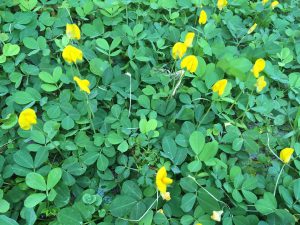
Perennial Peanut
Scientific name: Arachis glabrata
Cultivars: ‘Ecoturf’, ‘Arblick’, ‘Florigraze’
Plant Status: not native
Mowable: yes
Flowers: yes, yellow edible pea flowers
Butterfly host plant: no
Notes: may reduce growth, freeze back, or go dormant in the winter. This plant fixes nitrogen and requires little fertilizer.
Read more about establishing perennial peanut in this EDIS publication or watch this YouTube video.
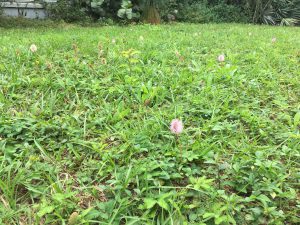
Sunshine Mimosa
Scientific name: Mimosa strigillosa
Plant Status: native
Mowable: yes
Flowers: yes, pink powderpuff flowers
Butterfly host plant: yes
Notes: may reduce growth and go dormant in the winter. Be careful it spreads and may need a barrier. Good for easements and also a nitrogen fixer.
Read more about mimosa on Gardening Solutions.
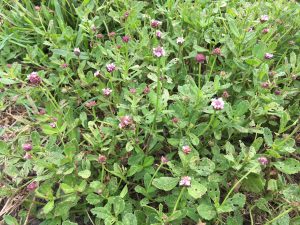
Frogfruit, also known as Fogfruit
Scientific name: Phyla nodiflora
Plant Status: native
Mowable: yes
Flowers: yes, small purple and white flowers
Butterfly host plant: yes, for the phaon crescent, buckeye, and white peacock
Notes: may go dormant in the winter, cannot withstand heavy foot traffic. This plant is both drought and flood tolerant.
Read more about frogfruit from the Florida Wildflower Foundation.
Basketgrass
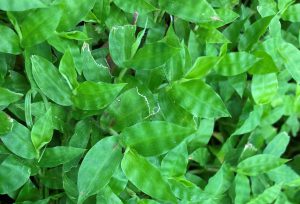
Scientific name: Oplismenus setarius
Plant Status: native
Mowable: yes
Flowers: yes, but inconspicuous
Butterfly host plant: yes, for Carolina satyr butterfly
Notes: can withstand foot traffic, grows in deep shade, goes completely dormant in the winter
Read more about basketgrass on the Florida Native Plant Society’s plant profile or our UF blog.
Asiatic Jasmine
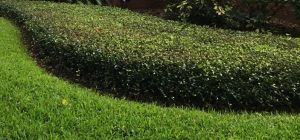
Scientific name: Trachelospermum asiaticum
Cultivars: ‘Bronze Beauty’, ‘Goshiki’, ‘Long Leaf’, ‘Snow and Summer’, ‘Summer Sunset’, ‘Variegatum’
Plant Status: not native
Mowable: no, looks best when trimmed
Flowers: yes, but often trimmed before flowering
Butterfly host plant: no
Notes: does well in shade, requires frequent pruning, not meant to be walked on.
Learn more about Asiatic jasmine on our Gardening Solutions webpage.
Twinflower

Scientific name: Dyschoriste oblongifolia
Plant Status: native
Mowable: no, or mow at the highest height
Flowers: yes, purple flowers
Butterfly host plant: yes, for Buckeye butterfly
Notes: a low growing evergreen wildflower that serves as a groundcover. Buy plants from native plant nurseries.
Learn more about twinflower from the Florida Wildflower Foundation.
Multispecies lawns
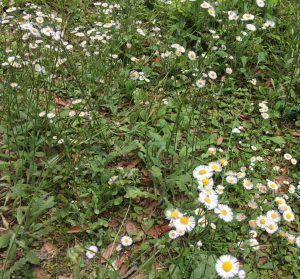
There are many other species of groundcovers and low growing plants that can be used in an alternative lawn that are mowable. Some native species include oakleaf fleabane, elephant’s foot, lyre-leaved sage, white clover, and spiderwort. Try a small patch and see what works in your yard. They require special management; let it grow in the winter and wait until after flowering and seeding to mow. Mixed together, they can be a beautiful display of wildflowers that is green, covers the soil, and attracts pollinators!
Want to learn more? Check out horticulture classes offered by UF/IFAS Extension Orange County on Eventbrite. Read about Florida-Friendly Landscaping™. Follow us on Facebook, Instagram and visit our website https://sfyl.ifas.ufl.edu/orange/home-lawns-landscapes-and-gardens/florida-friendly-landscaping/.
 9
9
